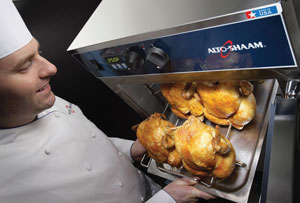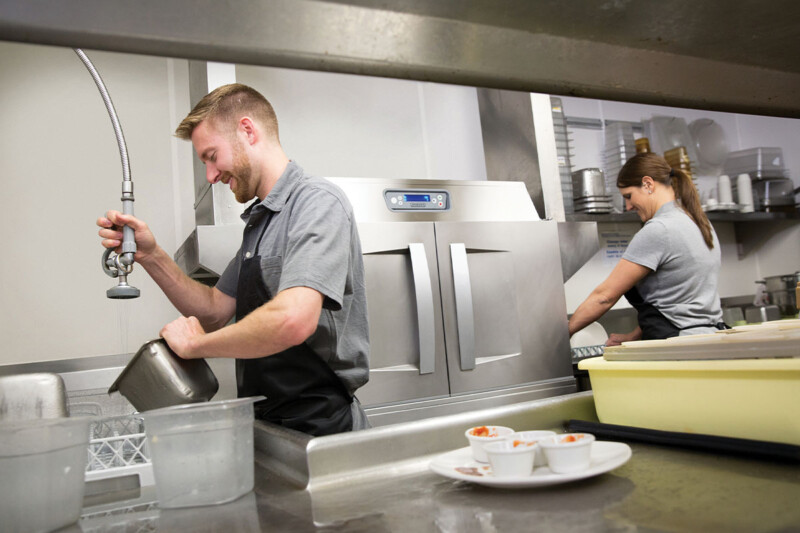
As the name suggests, cook-and-hold ovens cook foods and then hold them till you need them. But how do they differ from other appliances that cook or hold?
Comparing Available Options
For most of history, ovens were just ovens. They might be made of clay, brick, cast iron, or steel, but you knew what an oven would do. Today, you have regular ovens, convection ovens, combi ovens, accelerated ovens and cook-and-hold ovens. Each one does something different.
Conventional ovens cook food to a specifi c temperature, and then you’re done. Leaving the food in the oven will overcook it or dry it out. Convection ovens cook more quickly, by circulating air during cooking. However, they still simply cook food, and you’re done. Combination ovens, or combis, bring together convection and steaming. They are versatile and fast and retain moisture, but combis do not tenderize meat or hold cooked food. One manufacturer also notes that the boiler for most combi ovens is external, which adds a layer of maintenance and expense.
A cook-and-hold oven, on the other hand, cooks food slowly, at a lower temperature than a conventional oven, and when the food reaches the ideal doneness, the oven keeps the food warm, moist, and at that precise level of doneness until needed—even overnight for some foods. And they switch to that hold mode automatically after the cook cycle is complete. How low is low? While brands differ, with most cook-and-holds, temperatures range from 100°F to 325°F, with cooking cycles generally set at 200°F to 325°F and hold temperatures ranging from 100°F to 200°F.
Different manufacturers accomplish the cook-hold process in different ways. One uses conduction heat directly from the shelves, which contain heated fluid flowing throughout. Another wraps thermal cable around the cabinet for gentle, consistent heat. Despite varying technologies, it’s the outcome, rather than the method, that defi nes the cook-and-hold oven.
If all you want to do is hold food, a hot holding cabinet is an option, but keep in mind that holding cabinets don’t cook. They don’t even reheat food that has been chilled or frozen. They are engineered to hold already hot, cooked food at a safe serving temperature. However, because holding cabinets use hot air to keep food warm, the amount of time food can be left inside without losing quality is limited.
What Are They Good For?
Cook-and-hold ovens are great for meats. The low temperatures tenderize tough proteins and reduce shrinkage. The enzymes in meat that break down tough connective tissue are most active at lower temperatures, which is why “low and slow” has been the mantra for preparing tough cuts since time immemorial. Cook-and-holds are ideally suited for large proteins—but they can do so much more than just prepare a huge roast or multiple holiday turkeys.
Manufacturers agree, in fact, that cook-and-holds are remarkably versatile. One notes that they can braise and roast meat, proof bread dough and reduce sauces to enhance and intensify fl avors. Chefs use the ovens for fermenting, sous-vide cooking, confit, canning and other advanced culinary options. Other manufacturers report that these ovens have been used for cooking rice dishes, quiches, baked potatoes, fish, steamed vegetables and crème brulee. That might sound as though they’re just for high-end restaurants, but one manufacturer emphasizes that even fast-food operations can benefit.
Of course, cooking is not the only consideration when buying equipment. Because it’s versatile, a cook-and-hold oven can save space, doing in one oven the tasks of multiple pieces of equipment. These ovens come in a range of sizes, so you can likely fi nd one that fits the space you have.
Another very key consideration: Most cook-and-hold ovens do not require ventilation hoods overhead; that’s a huge space and money saver. When hoods are required, it’s the result of very strict local health- and building-code requirements, which you’ll find in some regions. In most areas, these ovens won’t need hoods.
Reduced shrinkage and waste, along with consistent quality, can save money, too. These ovens also make it possible to prepare food ahead of rush periods, and hold those foods at their peak until needed. Plus, cook-and-holds are very energy efficient.
The best applications for cook-and-hold ovens are ones in which you have ample time to cook. Cooking large proteins is where the cook-and-hold oven really shines. And some cuts, which are cheaper to purchase, are very flavorful when slow cooked. Temperatures are high enough to quickly cook small proteins, such as fish and chicken, as well as the other applications mentioned above, and they can do it in the same amount of time as a conventional oven. But for cooking large roasts of meat or pork or whole birds, they’re hard to beat.
With a cook-and-hold, you can choose to cook by time or use a probe that precisely measures the internal temperature of what you’re cooking. Then, at the time or temperature you selected, the oven automatically switches into “hold” mode, keeping the food at the temperature you want.
Another option offered by a cook-and-hold is smoking. Many manufacturers offer smoking accessories as add-ons, so you can bring that popular flavor profile to your kitchen. However, manufacturers do recommend that, if you select the smoke option, you have a dedicated cook-and-hold smoking oven, to keep the smoke flavor from carrying over to other foods.
And when not cooking, a cook-and-hold can reheat or hold prepared foods, but with less drying out and shrinkage.
Making The Decision
When trying to decide if a cook-and-hold belongs in your kitchen, one of the fi rst things to do is consider your menu, both present and potential future. Then think about the pace at which you serve food. Consider, too, how much space you have. Then start gathering information about available options.
Most cook-and-holds are constructed of stainless, which is strong and durable, easier to clean than some materials, and offers excellent insulation. Doors are generally solid steel. Some manufacturers offer glass doors as special orders. Others don’t offer glass at all.
All manufacturers offer a range of sizes, so fi gure out how much capacity you need, as well as the space you have available. Sizes can be full, half and countertop. Capacities can range from 36 lb. of meat to 240 lb., and the largest ones can hold up to 750 lb. of meat.
The appearance of the final product can vary by brand. Some manufacturers relate that large roasts with long cooking times brown naturally; others say browning is limited. Several relate that smaller items will have virtually no color, but cooks can brown the product before cooking; or they can cook the product, hold it until needed, and finish it on a grill or broiler before serving. So, talk to a vendor to find out what they recommend for their equipment. One cook-and-hold maker’s unit uses water for internal humidity but most cook-and-hold units do not use or require any water connection.
Again, you’ll want to check local codes on ventilation, because this can have a big impact on cost, as well as on space. Any oven that is EPA 202 approved (and the good ones are) doesn’t need a ventilation hood in most regions—but if you’re in one of the regions that requires hoods for every piece of cooking equipment, regardless of rating, it is vital to find that out up front.
Ask if you’re able to monitor the progress of your cooking. If you are new to cook-and-holds, ask about recipes and cook times. These will differ from conventional ovens. Probes and presets are add-ons that can increase the purchase price but can ensure consistent quality.
When thinking about return on investme nt, don’t just look at the purchase price. Ask about the efficiency of the oven.
One manufacturer notes that, because of the evaporation at the heart of the cook-and-hold, the chemicals found in all treated water will concentrate so, daily cleaning is essential. So, fi nd out how diffi cult it is to clean. The more challenging the cleaning cycle, the higher the labor costs.
While you’re thinking about where you’re going to put your new oven, make sure you have adequate electricity. You probably also want to review the warranty, as warranties can vary, and you want to get one that you’re comfortable with.
One manufacturer says it’s vital to fi nd out what’s out there. Another strongly urges talking with a consultant and, if possible, seeing a demo. Spend time with the oven, trying to imagine what you might do that you can’t do now. Adequate research can help ensure a happy “relationship.”
Cook-And-Hold Oven SUPPLIERS
Alto-Shaam
alto-shaam.com
Bevles/The Legacy Cos.
thelegacycompanies.com
Carter-Hoffmann/Middleby
carter-hoffmann.com
Cres Cor
crescor.com
FWE/Food Warming Equipment
fwe.com
Nu-Vu/Middleby
nu-vu.com
Thermodyne Foodservice Products
tdyne.com
Vulcan/ITW FEG
vulcanequipment.com
Winston Industries
winstonfoodservice.com
Wittco Foodservice Equipment
wittco.com
For more cook-and-hold oven suppliers, search the FER Buyers Guide at fermag.com.
RELATED CONTENT
- Advertisement -
- Advertisement -
- Advertisement -
TRENDING NOW
- Advertisement -
- Advertisement -
- Advertisement -


